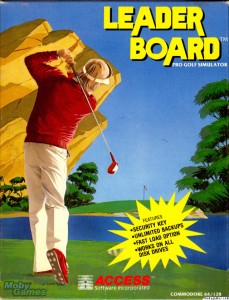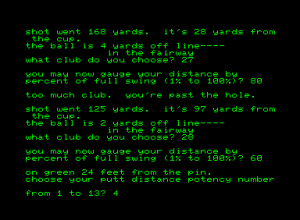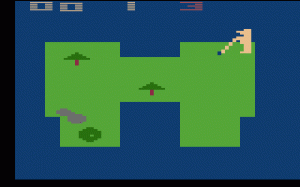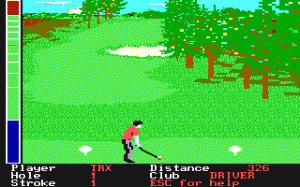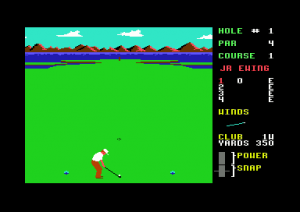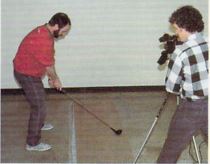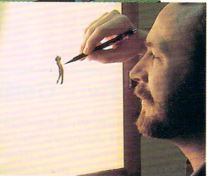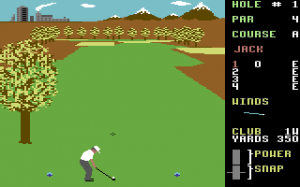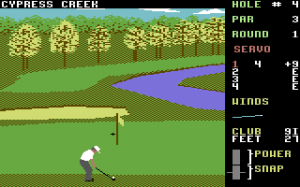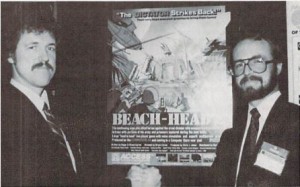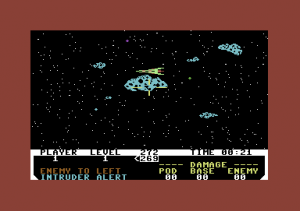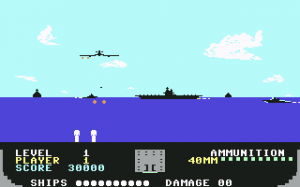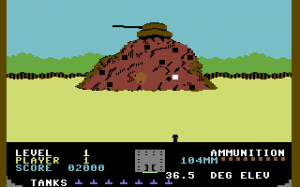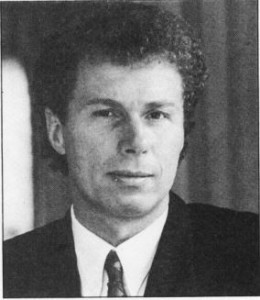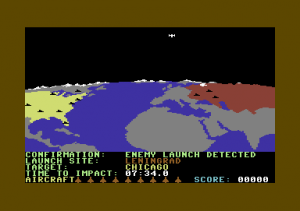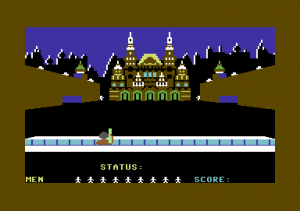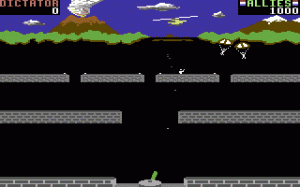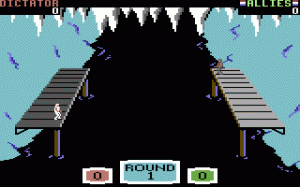Like just about every other sport, golf made it to computer screens quite early. A textual version was passed around in BASIC circles even before the arrival of the trinity of 1977, and was included in the landmark 1978 book BASIC Computer Games. Two years later, Atari released their blandly if descriptively named Golf cartridge for the VCS. Yet neither of these crude efforts, nor the ones which followed over the next few years, did the sport much justice. Those that had graphics at all were all played from a disembodied overhead perspective that could make them feel more like pinball than golf, and no one came close to computerizing the mix of science, art, and exquisite terror that is the golf swing. Then, as these things so often happen, a whole field of golf games appeared in 1986 which showed their courses from an actual golfer’s perspective and put the player’s focus squarely where it belongs, on the swing itself.
Of this suddenly crowded field the two most popular turned out to be Accolade’s Mean 18 and Access’s Leader Board. If you try them both out today, you’re likely to be more impressed, at least initially, by the former than the latter. Mean 18 is a much more complete simulation of the real game, including trees, sand traps, water hazards, varying elevations, re-creations of actual courses, even the chance to make more courses of your own with an included editor. Leader Board, on the other hand, turns you loose in a surreally minimalist environment of empty land and water and absolutely nothing else. On a bullet list of features, there’s no comparison. Yet if you play them both a bit you might just find that Leader Board, for all that it lacks, nevertheless feels better. For me anyway, it’s just somehow more fun. But even if you still prefer Mean 18, Leader Board deserves respect, as well as the chance to be graded on something of a curve. While Mean 18, you see, ran only on the bigger 16-bit machines, Leader Board was born and bred on the humble Commodore 64.
Given the technical and conceptual achievement it represents, I thought we’d do something we haven’t done in quite a while: look at Leader Board as the Carver brothers would have seen it, from the perspective of designers and programmers putting it together piece by piece. I will get just a bit technical in some of what follows, so you might want to review my earlier articles on the Commodore 64 and its capabilities, as well as the parts of my Elite history that dealt with the fraught transition from 2D to 3D graphics.
So, the Carver brothers wanted to create a golf simulation from a 3D perspective on a computer with a 1 MHz processor and 64 K of memory. Where to start? Well, the first thing to do was to simplify the bounds of the simulation brutally, out of the knowledge that anything you abstract away today represents the best kind of work, the kind that you don’t have to do at all. Any simulation is a simplification of reality. The art of the science is figuring out just how much detail is necessary. Suffice to say that the Carver brothers drew that line much farther along than anyone could get away with today. Maybe they could add some complications back in later, once they had an initial working version. In the meantime, much of what we think of when we think of the game of golf got tossed out the window, not without the occasional groan of regret: trees, sand traps, any notion of fairways as opposed to roughs, any notion of a putting green as anything other than a perfectly circular area around the hole with a radius of 64 feet, any concept of elevation when not on the green. Wind made the cut, but with the odd yet simplifying quality that it will always blow in the same direction relative to the golfer no matter which way he faces.
Despite all the editing, the Carvers still needed to map a 3D landscape, simplified though it may be, into the Commodore 64’s memory and be able to display the scenery in proper perspective from any location, facing in any direction, as the player hacked her way toward the hole. Additionally, given the success their earlier games had enjoyed in Europe it was critical to them that this one also be playable from cassette, meaning the whole program — including the four separate 18-hole courses they wanted to include — should reside in memory at once. This was hardly playing to the natural strengths of the 64, whose graphics had been designed with 2D sprite-based games in mind. The solution they arrived at was to first design and store about 30 different polygons, each of which could be used to represent an “island” on the course, which was otherwise assumed to be pure water. Each hole of each course could then be built by arranging these islands, up to seven of them per hole, in different, often overlapping configurations. Just as his tile-graphics system allowed Richard Garriott to build huge worlds by mixing and matching reusable chunks of landscape, these reusable polygons saved the Carvers gobs of precious memory. The views of the course must be drawn using the Commodore 64’s multicolor bitmap mode; they were too irregular for character graphics. Thus every bit of memory saved was doubly precious, as a multicolor bitmap display consumes a full 10 K of the 64’s 64 K. If you look at the diagrams of the holes, you can see how they’re all built from the same pile of interchangeable parts.
By applying the mathematics of 3D perspective, it was now possible to display views from any arbitrary location and facing for every hole — the first necessary step for a 3D golf game. As you can see from the video clip a bit further down the page, when playing the game you can actually watch each polygon/island being drawn in outline form and then filled in with color as each new perspective of the course is generated.
Next must come the golfer himself. It was hugely important to the Carvers that he should make a correct, believable swing. Bruce therefore filmed Roger taking swings under carefully controlled conditions using a high-quality video camera. About every fourth frame of the swing was developed as a slide and projected onto a glass screen, from which Roger could trace it onto graph paper using colored pencils, to be translated from there into the grid of bits that makes up each frame of each sprite in the Commodore 64’s memory. Or rather, six different areas of the image were each individually translated: the actual golfer, club included, is built from no fewer than six of the 64’s eight available sprites, each of a single color and carefully placed in relation to its siblings; thus the golfer’s white shirt and hat are made from one sprite, his brown pants from another, his black club from yet another, etc. (Although Bruce Carver first made his reputation through his mastery of multicolor sprites, Leader Board actually makes no use of them.) As the golfer goes through his swing, each sprite steps through its own sequence of bitmaps to recreate as closely as possible the smooth swing that had been originally captured on video.
Now how to have the player actually control the swing? After much experimentation, the Carvers hit upon a system that didn’t try to duplicate the actual motions of a swing via complicated joystick jerks of the sort Epyx tended to favor in their Games series, but somehow just felt better than anything else. (The developers of Mean 18 came up with an almost identical system simultaneously but apparently independently.) This so-called “three-click” system has persisted with only modest variations for decades as the go-to control scheme for computerized golf; any new game that deviates from it always provokes intense debate, and those that opt for something other than this by now traditional approach often all but define themselves by their rejection of the golf-swing status quo.
In Leader Board, then, you first aim the shot horizontally with a small targeting cursor, then press and hold the joystick button to begin your back swing. You release it when you’re ready to end the back swing — more back swing will hit the ball farther — but must be careful not to wait too long. The golfer now begins his forward swing. Hit the button again just as the club strikes the ball to “snap” it straight, or slightly before or after to deliberately — or, more likely, accidentally — hook or slice it to the left or right. Timing being so critical in this, the very heart of the game of golf whether played in the real world or on a computer, the simulation here had to be absolutely smooth, consistent, and precise. As in many other places in Leader Board, the Carvers took advantage of the Commodore 64’s timer-interrupt system to be sure of this. (Timer interrupts work similarly to the raster interrupts I discussed in an earlier article, except that they are triggered not by the movements of the electron gun which paints the screen but rather can be set to occur at a precise interval of microseconds.)
After the ball is struck, its X, Y, and Z vectors are calculated, taking into account the swing itself, gravity and air resistance, and, if you’re playing at “Professional” level, the wind. The ball is represented by a seventh sprite, which can have a number of possible sizes depending on its distance from you. In a nice touch that adds a welcome note of verisimilitude, the eighth sprite is employed as the shadow of the ball in flight; before the ball is struck, when it’s lying on the ground before you, this sprite is used to represent the targeting cursor. The movement of the ball and its shadow are again tied to the 64’s interrupt timer to assure that they are absolutely smooth and believable. If the sprite lands in the water, you have to try again; likewise, in yet another simplification, if you send it off the screen to left or right. Otherwise another view is generated from where the ball landed, and the hole continues. It is possible to hit the ball directly into the hole from the fairway, even to score a hole in one on some of the shorter holes, but it’s very, very difficult; in the couple of dozen complete games I’ve played recently (we got a bit obsessed with Leader Board around here for a while), I’ve managed it exactly once.
More commonly, you’ll eventually end up on the putting green, defined in Leader Board as simply an arbitrary circle 64 feet in radius around the hole. With no need for the concept of a snap, the control scheme is here simplified: just aim with the targeting cursor, then hold down the button until the power meter reaches the desired level, keeping in mind that a ball that’s traveling too fast when it reaches the hole will bounce right over it.
In order to make putting any real challenge, the Carvers were forced to add back in the concept of elevation they had excised from the rest of the simulation. The problem became how to portray slope on the relatively small surface of the green given a screen resolution of just 160 X 200. The ideal method would have been to add color shading to visually indicate contour, but they already needed to keep available four colors — the maximum permitted by the Commodore 64’s VIC-II graphics chip in any 4 X 8-pixel region — for drawing the other elements of the landscape. The somewhat kludgy and not entirely intuitive solution became a visual indicator, conveniently drawn in two of the available colors, to the left of the golfer. The vertical line represents the magnitude of the slope; the other represents its direction. The same system is used to represent wind intensity and direction when not on the green.
With that, plus a small battery of sound effects which are often cleverly reused — for instance, the splash when a ball strikes water is always the same waveform played at one of four volumes depending on the distance of the ball — the Carvers had something quite special, if also something that was, like any game, full of sacrifices and compromises. They had always seen this minimalist world of green land and blue water as a mere jumping-off point. Now, however, their planned shipping date loomed, and Access wasn’t in a financial position to miss it. Therefore Leader Board went out the door as-is very early in 1986. When it proved a hit, the Carvers happily returned to the Leader Board well again and again: via Leader Board Tournament, a bare-bones sequel featuring four new courses but the same engine; via Executive Leader Board later in 1986, which added sand traps and trees; and finally via World Class Leader Board and three course expansion disks (Famous Courses of the World) in 1987 and 1988. By this time, the Carvers had something that approached a real game of golf, with real-world golf courses like St. Andrews and Pebble Beach, fairways and roughs and a whole variety of trees and other hazards, and variably shaped and sized greens. They had also largely remade Access in the eyes of gamers, from the Beach-Head company to the Leader Board company. Having accomplished all they felt they could on the Commodore 64 and seeing which way the industry winds were blowing, the Carvers now turned to bigger MS-DOS machines and what would become the most successful golf franchise of all, Links — a story for another time.
Before we say goodbye to Leader Board, I want to take a moment here to say just how ridiculously entertaining it is, even in its most minimalist configuration. There’s something elegant and classic about those bifurcated, abstract landscapes of the first Leader Board — enough so that, while the later Leader Boards are certainly more impressive as golfing simulations, I’m not entirely sure they’re all that much better as computer games. Leader Board is an engaging little diversion played alone against the course, trying to come in under par (there is no computer opponent available). But get some friends together and it’s absolute magic, like so many of the best Commodore 64 games and so many of my personal favorites. Find yourself an open-minded friend or two or three who are willing to overlook 8-bit-era graphics and give it a shot; I’ve prepared a download that includes the original Leader Board, Executive Leader Board, and World Class Leader Board — which I think I can without causing a great deal of controversy call the definitive 8-bit golf game — with all the course disks also included courtesy of some ingenious hackers from the days of yore. Fire up a Commodore 64 emulator and try it even if you wouldn’t be caught dead on a real golf course. Golf just works on a computer, as millions of players with no interest whatsoever in the real game have discovered over the years. A grand tradition begins in earnest right here.
(Sources this time out are the same as for the last article.)
